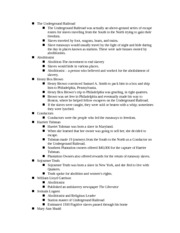
Hoeing and harvesting fields was certainly exhausting, but Tubman preferred the straightforward outdoor work to doing the bidding of an abusive master like Miss Susan. This cycle would continue for years to come: Tubman would be sent off to work in different homes, then be sent home again so that her family could nurse her back to health.īy the time she turned 12, Tubman was shifted away from domestic work and began working in the fields instead. If the baby cried, Miss Susan would whip the young Tubman, giving her scars that would stay with her for the rest of her life.Įventually, Miss Susan kicked Tubman out of her home and sent the malnourished and fragile young girl back to her family. One of her first jobs was caring for the infant son of “Miss Susan,” one of the local neighbors. Unfortunately, this was to be one of many traumatic experiences in Tubman’s life.Īt just five years of age, Tubman’s master began sending her to nearby families to do domestic work in appalling conditions. Harriet Tubman was no exception: at a young age, she witnessed two of her sisters being taken away from her family. Many slave families lived through the trauma of seeing their brothers, sisters, sons and daughters taken away by Georgia traders. These were slave traders from the South who would travel to Maryland and purchase more slaves for plantations in their home states. Most often, slave masters cared little for families and sold children to Georgia traders. Many even ended up being sold off for the simple reason that they were pregnant, as this prevented the women from performing many physical tasks. On the other hand, pregnant women were seen as a liability. On one hand, they needed women like Harriet Green to give birth to more slaves, since America’s involvement in the international slave trade had ended in 1808. Slave masters were uncertain about the benefits and risks of slaves forming families. One thing that was true for most families of slaves is that they were at constant risk of being torn apart. It’s likely that Tubman was one of ten siblings, though reports of how many children there were in the family conflict with each other, too. Her mother’s name was Harriet Green, and her father was Benjamin Ross.


Tubman herself believed that she was born in 1825 most historians suggest, however, that she was born in 1820 or 1822.

As was the case for most people born into slavery, Tubman’s birth was undocumented. She was born near Bucktown, Maryland, but her birth year and date are still contested today. We know that Tubman’s birth name was Araminta Ross. Do you know who Harriet Tubman was? Many of us know that she was born a black slave, but that’s one of just a few facts that we can be entirely certain about the life of Harriet Tubman remains shrouded in mystery.


 0 kommentar(er)
0 kommentar(er)
